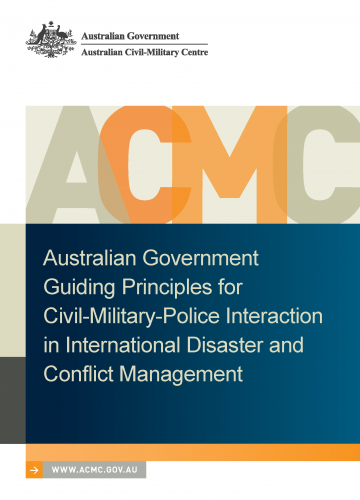Interagency Operational Effectiveness
Interagency operational effectiveness in response to international complex emergencies and humanitarian crises refers to the way in which the roles, functions and resources of each agency are used together to implement the strategy and achieve whole-of-government outcomes.
As operational effectiveness is largely a reflection of the practices and processes of the interagency operation, continuous improvement (through training, exercises and review) is an important element in enhancing future operations.
Success Factors – Interagency Operational Effectiveness
The operating contexts of interagency responses are complex and multidimensional, including:
- the nature of the conflict or crisis, and the political, economic and environmental context and implications
- the context, culture and needs of the affected society or community
- the distinctive roles and capabilities of the responding agencies
- the need to focus at multiple levels (individual, community, society, national, regional, international)
- the combination of individual, agency, sector, field-based and Canberra-based operations.
While the context of each response is different, the following factors contribute to the operational effectiveness of interagency responses identified in policy documents as well as the research literature.
Guiding Principles
The Australian Government Guiding Principles for Civil-Military-Police Interaction in International Disaster and Conflict Management (Guiding Principles) was developed in consultation with Australian government agencies participating in interagency responses and outlines a set of agreed strategic principles to guide policy and planning for interagency and multiagency responses. The principles recognise that the key to operational effectiveness is a collaborative culture.
The success factors outlined below are also outlined in more detail in the Guiding Principles.
Australian Government Guiding Principles for Civil-Military-Police Interaction in International Disaster and Conflict Management
- Clearly define strategic objectives and operational roles and responsibilities
- Engage proactively
- Share knowledge and understanding
- Leverage organisational diversity
- Commit to continuous improvement
Clear Purpose and Strategy
A common understanding of and commitment to the strategic objectives of the response operation and the respective roles and contributions of participating agencies is critical.
Situational Awareness
Interagency responses need to be aware of the local context and cultures of the affected society as well as the differences in capabilities and styles of the other agencies contributing to the response.
Coordination, communication and information sharing
The structure, roles, protocols and systems used in interagency responses should support effective coordination and communication, including sharing relevant information between agencies.
Collaborative Partnerships
Interagency responses require a culture of collaboration. Collaboration usually flows from the practices that precede the response and are developed over a long period—for example, partnerships, networks and joint planning, training and exercises.
People Capabilities
While agencies focus on the development of capabilities specific to their role, including technical and managerial capabilities, there are capabilities that are important in the interagency context, in relation to specific knowledge and skills as well as the individual’s attitude and approach, which is sometimes referred to as the ‘coalition personality’.
Tools and Resources
The Coalition Personality
The Coalition Personality forms part of the Australian Interagency Preparedness Framework
Members of a multiagency team who demonstrate the coalition personality:
- work towards a common and shared goal
- are resilient (in demanding and challenging situations)
- are flexible and adaptable can get on with people and work in a team environment
- are aware of themselves and others are willing to see others’ perspectives
- are culturally aware and sensitive.
The characterisation of the coalition personality focuses on the individual and how they behave in a team; however, there is also a collective element to the coalition concept—the coalition culture. Building a coalition or collaborative culture across agencies is also not a simple or short-term endeavour and results from a range of factors:
- a common purpose
- shared values (that support collaboration)
- an environment that acknowledges and rewards collaboration
- processes, structures and tools that enable collaboration (or remove/reduce barriers to collaboration).
Building a coalition or collaborative culture is a shared responsibility, with leadership making the desired culture explicit and ensuring alignment between this expectation and mission plans, policies, structures, systems, processes, etc.
Continuous Improvement
Capturing the lessons learned from interagency responses and from joint training, exercises and other events will identify areas for improvement in the conduct of future interagency responses.
Application of Success Factors as Each Level
Interagency responses involve contributions at three levels: individual, organisation and whole-of-government. The following table identifies the application of the above success factors at each of these levels.
| Success Factor | Whole-of-Government | Agency | Individual |
|---|---|---|---|
| Clear purpose and strategy |
|
|
|
| Situational Awareness |
|
|
|
| Coordination, Communication and information Sharing |
|
|
|
| Collaborative partnerships |
|
|
|
| People Capabilities |
|
|
|


